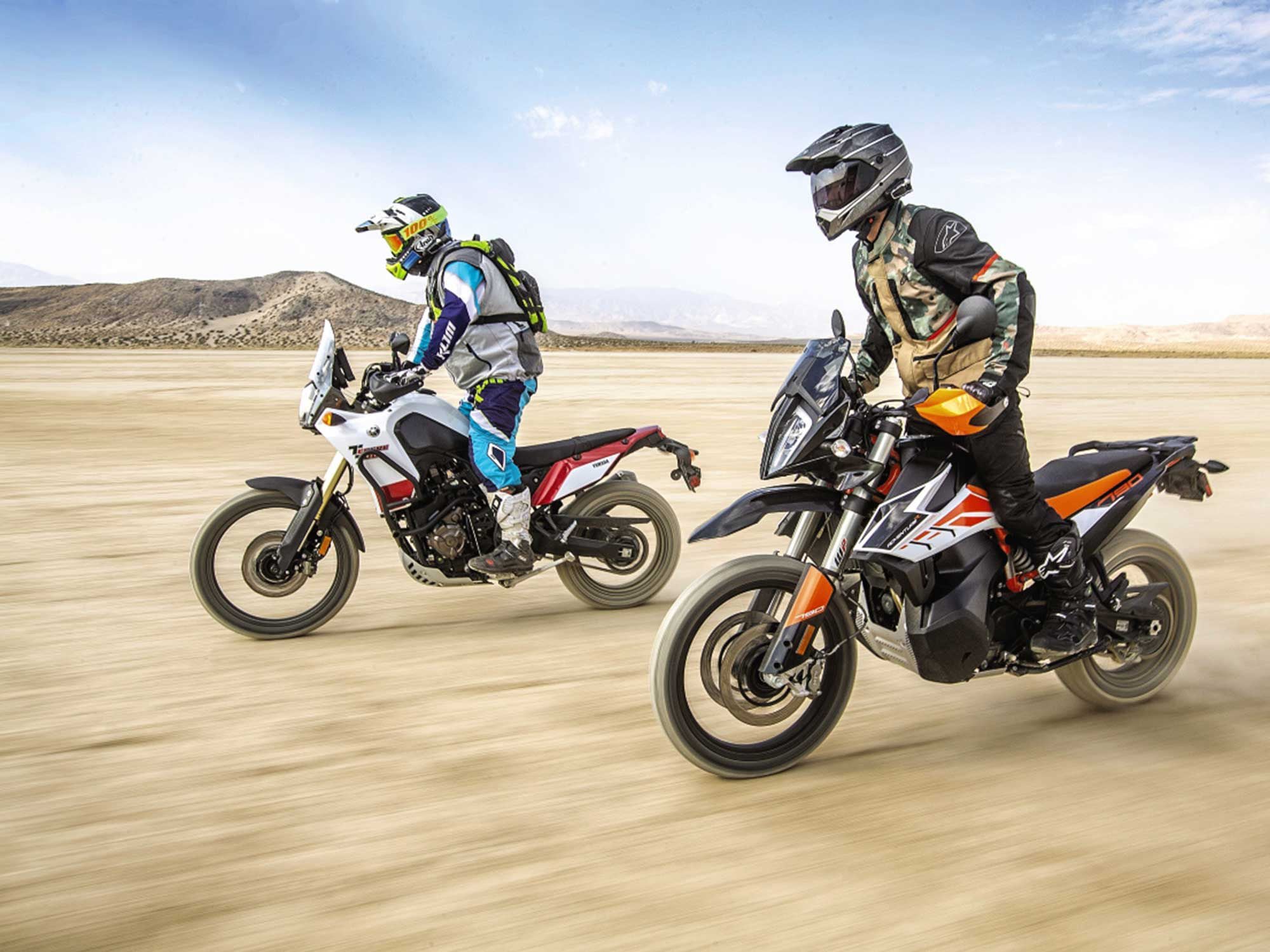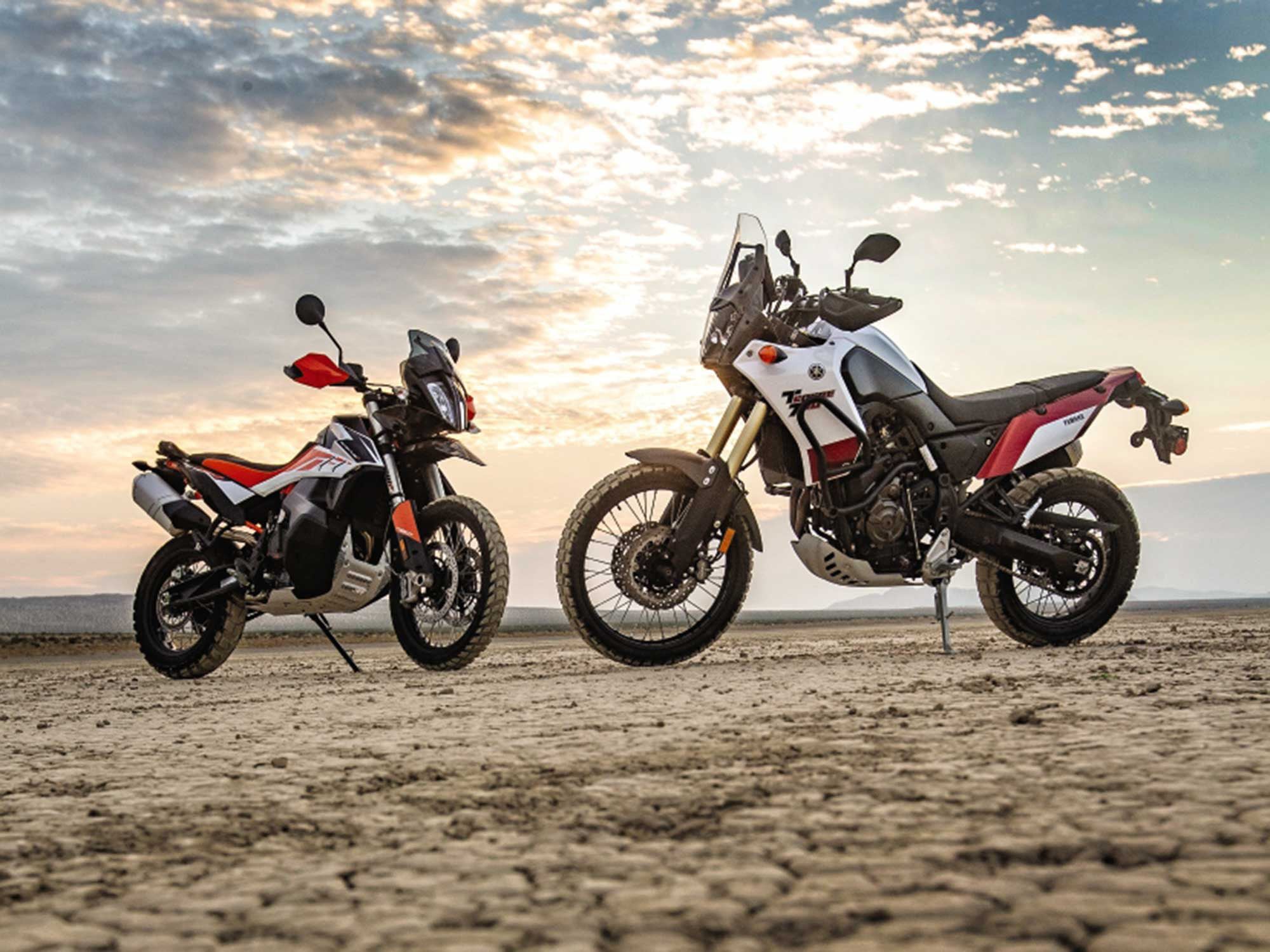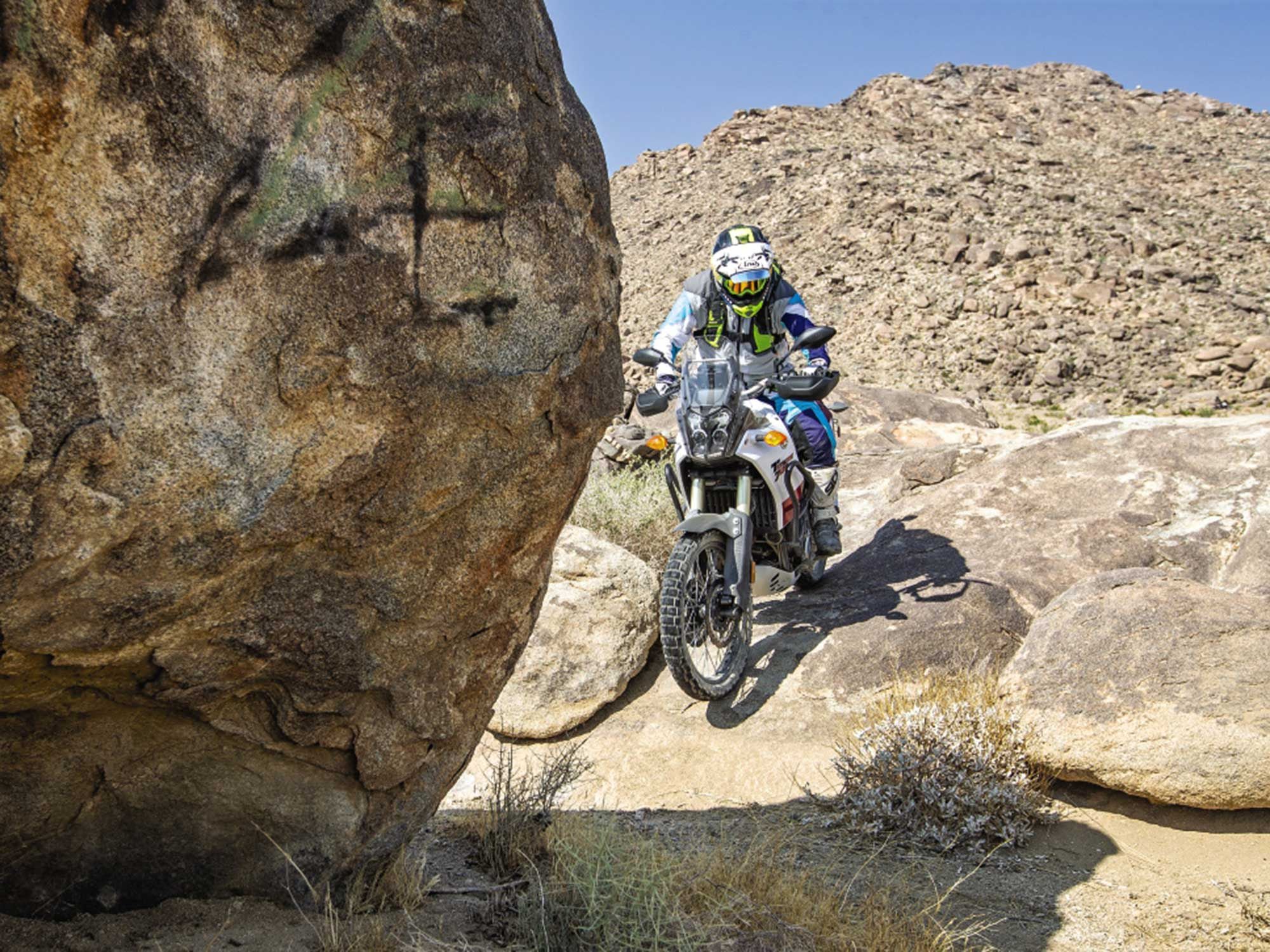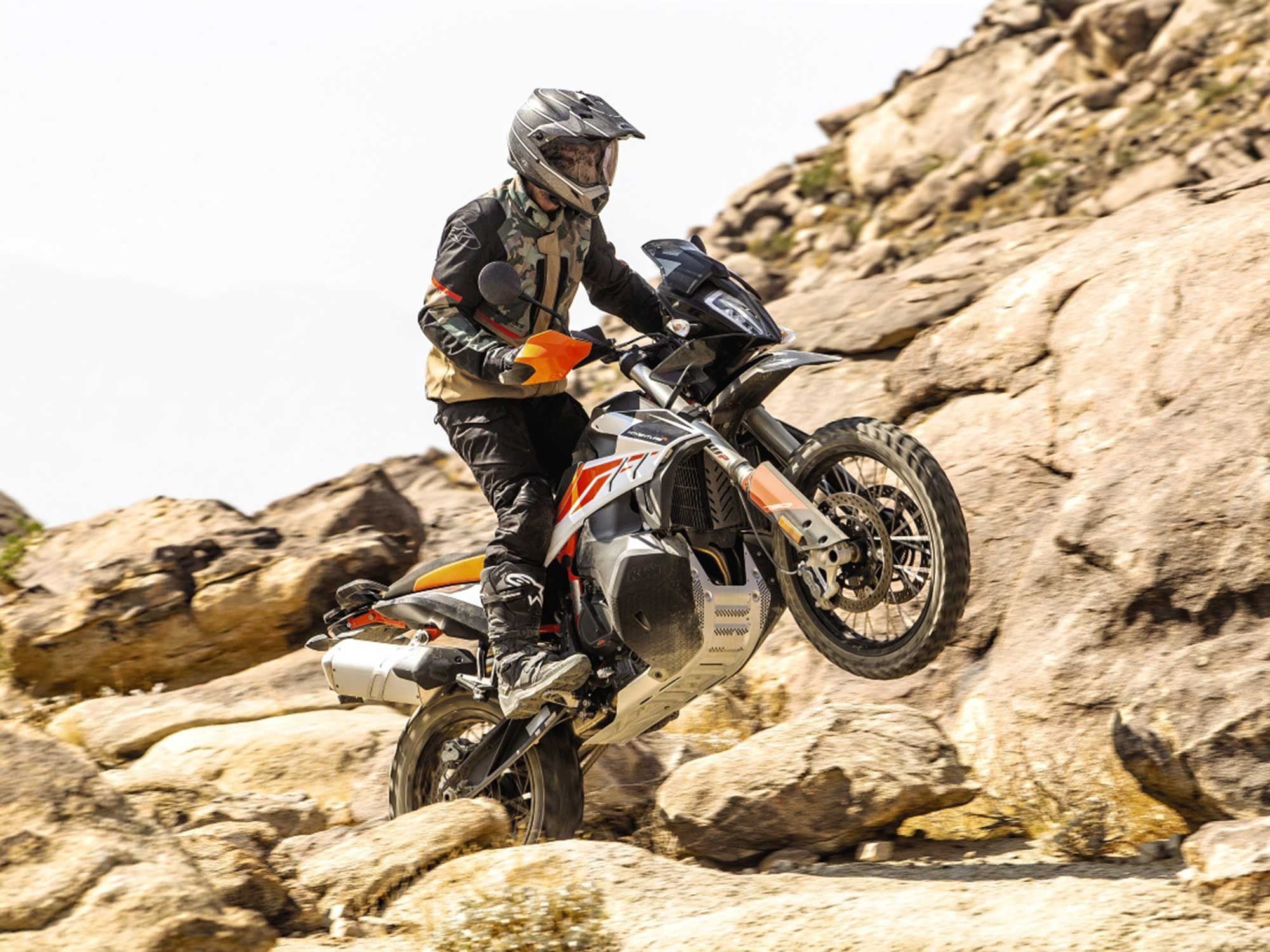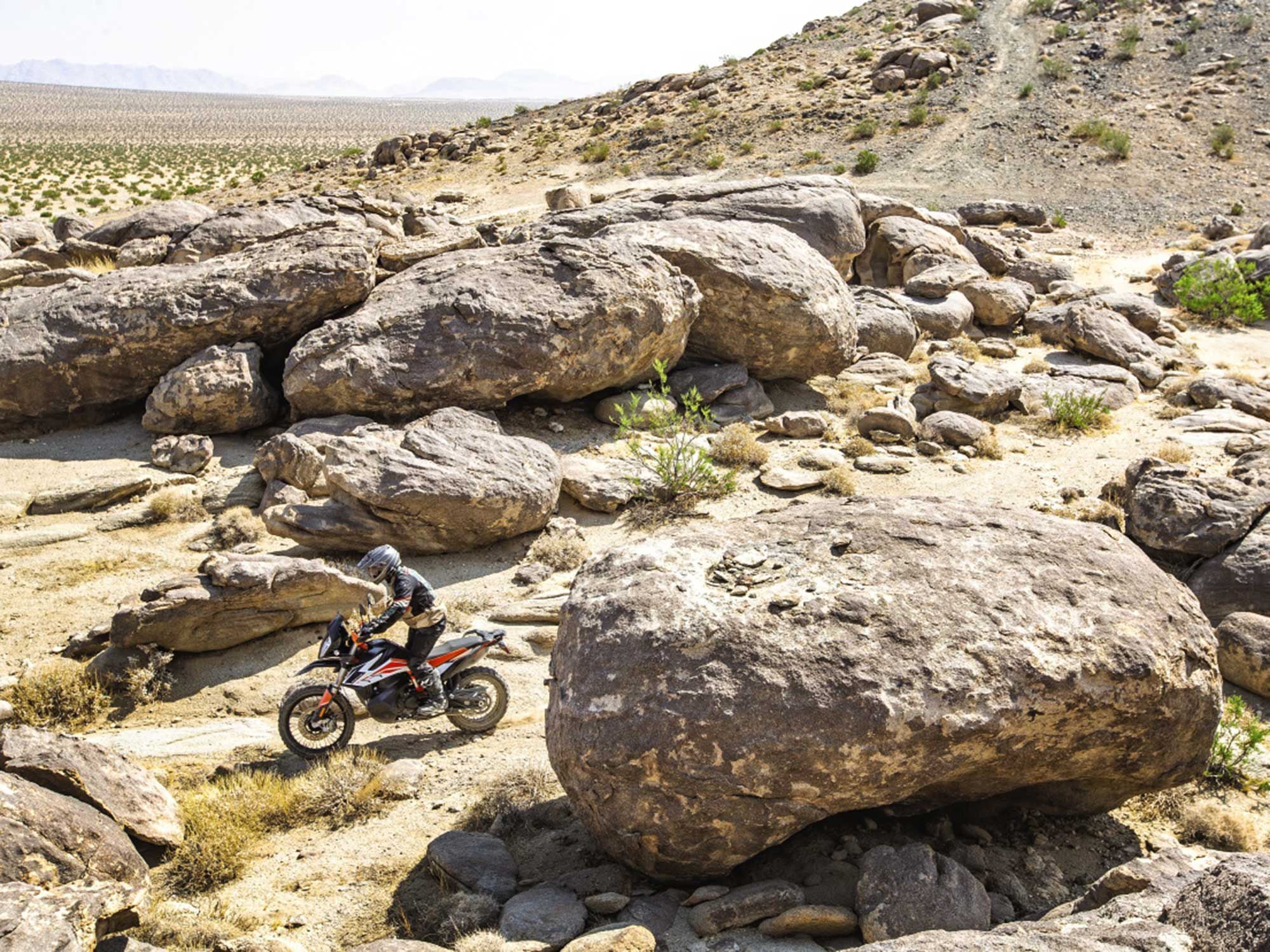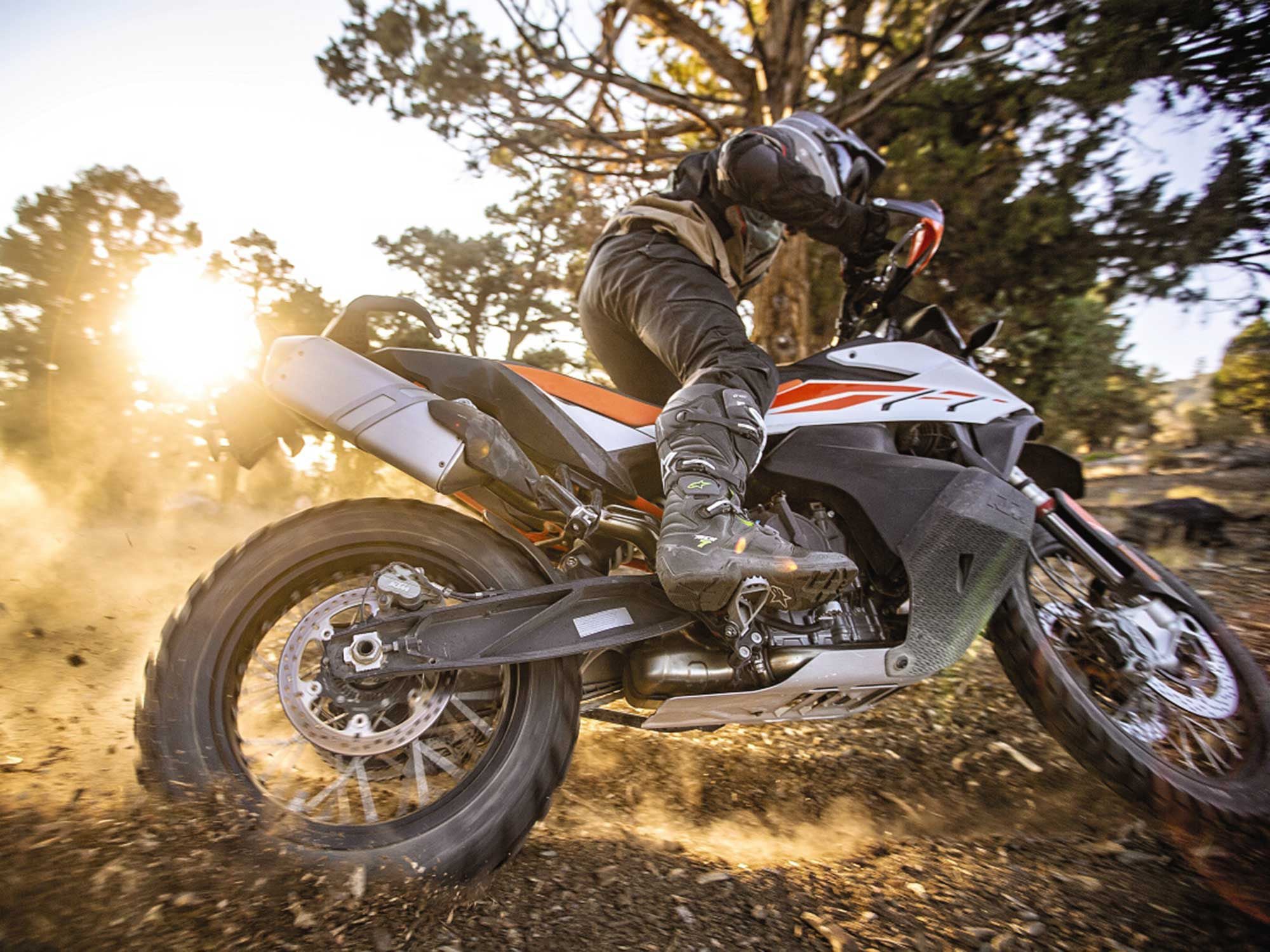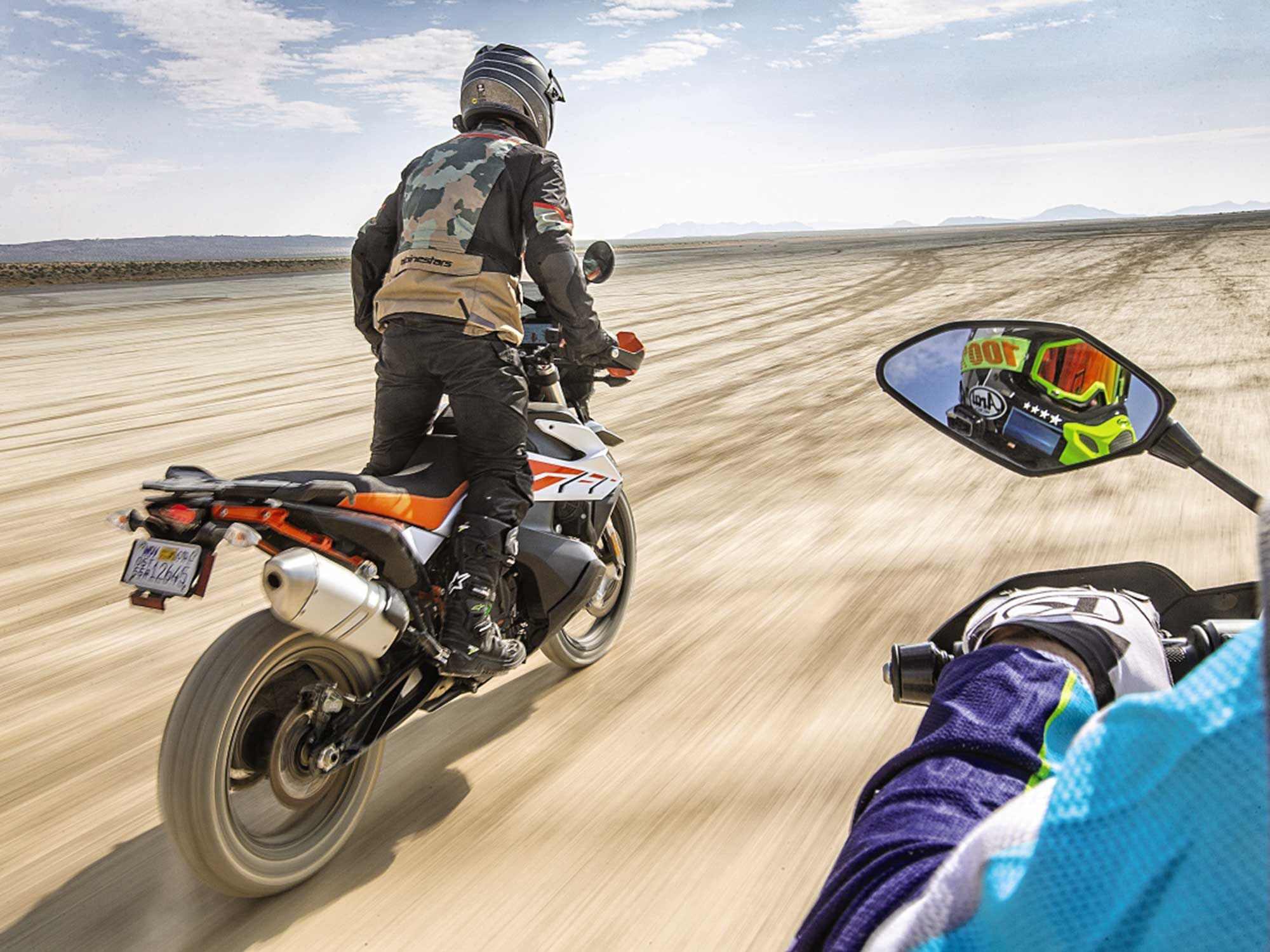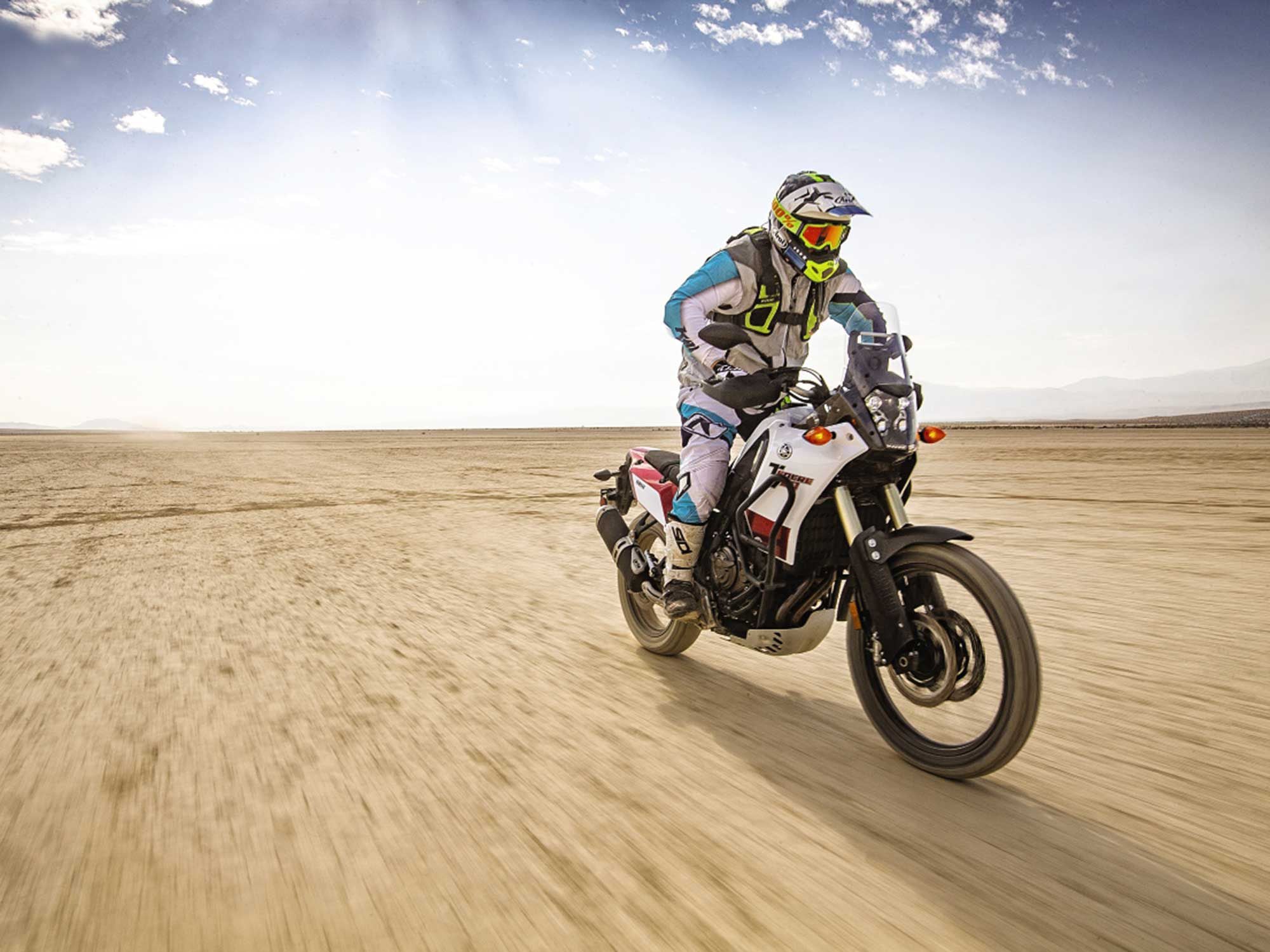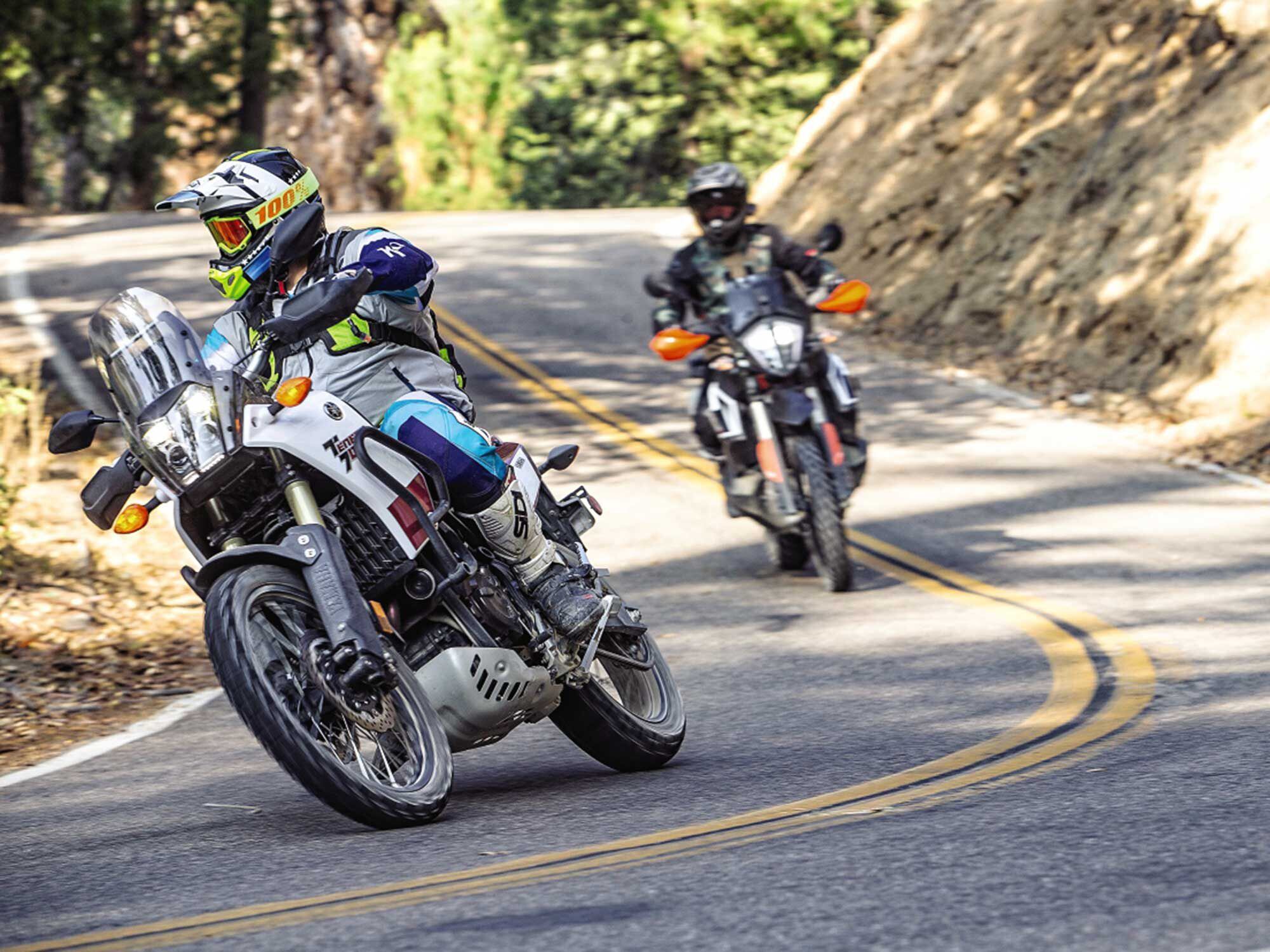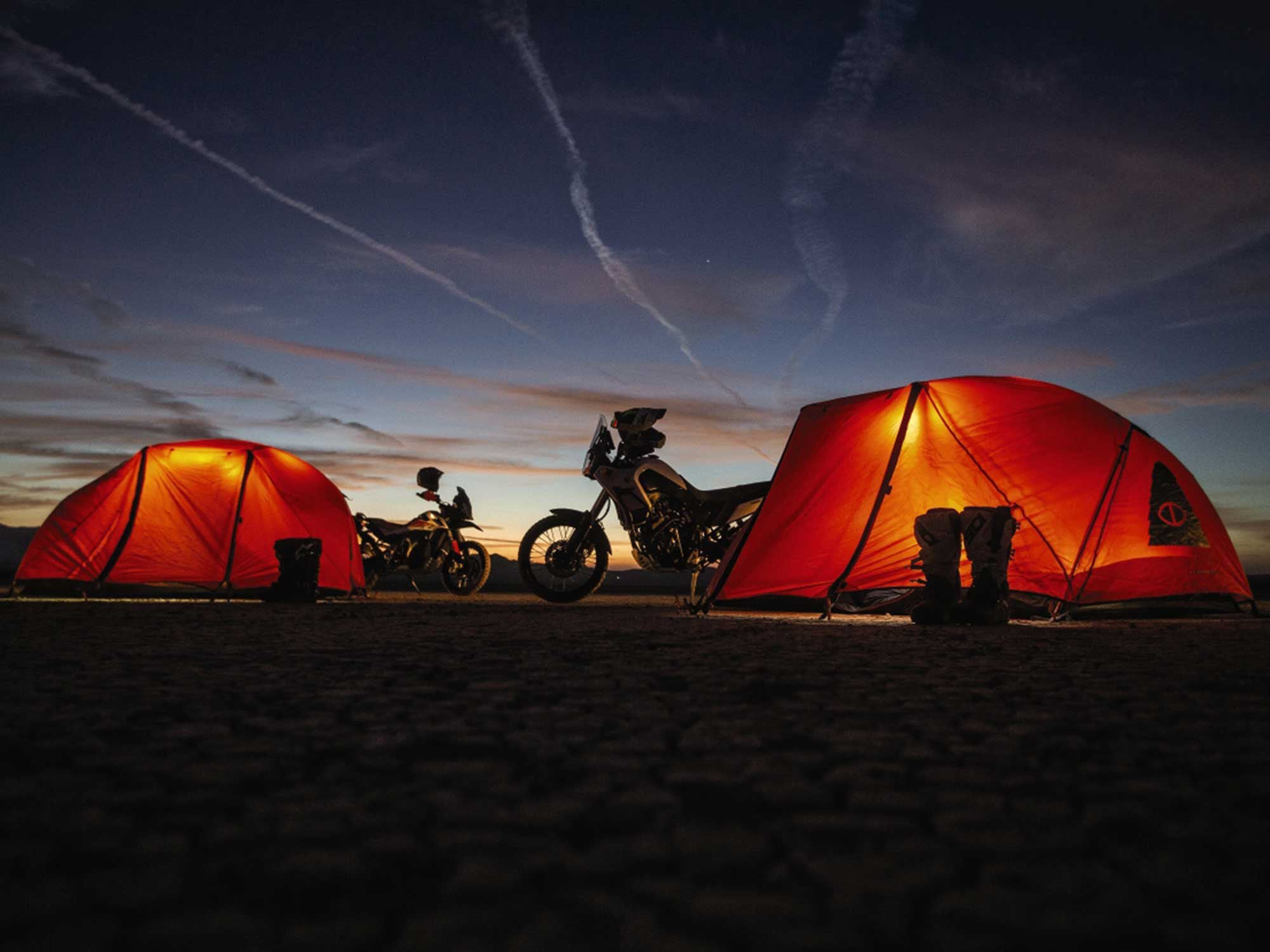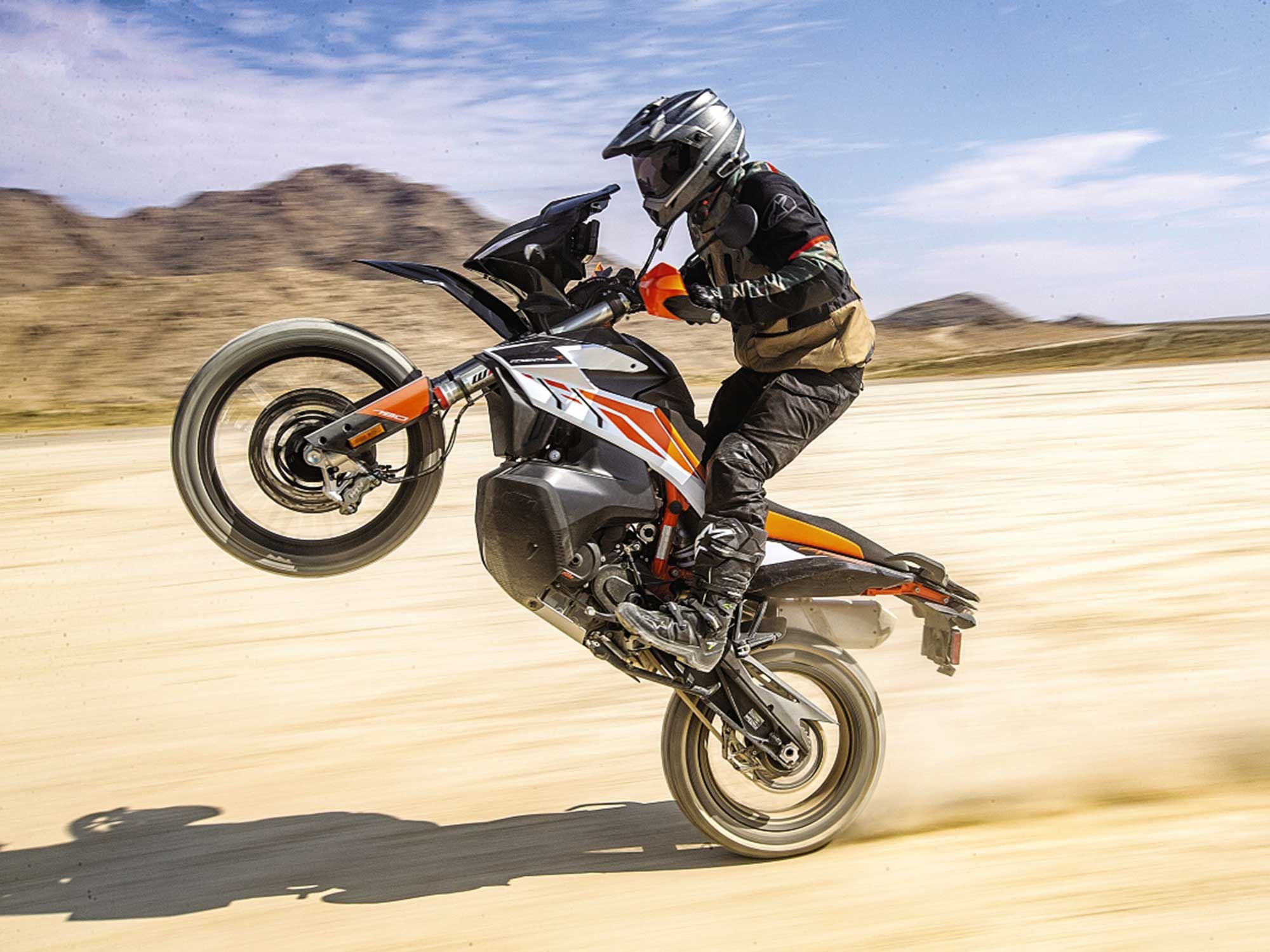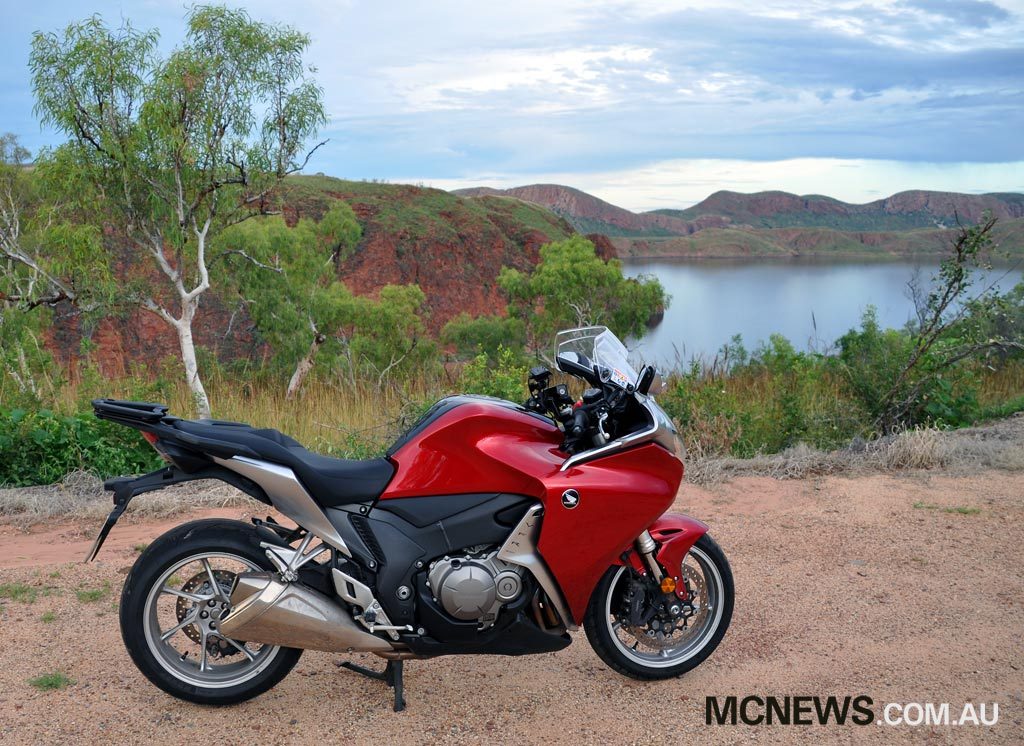The adventure motorcycle segment kicked off in 1980 with BMW’s R 80 G/S. At the time, many wondered who would want an overweight, under suspended dual-sport. Turns out, more riders wanted one than anyone would have guessed. The segment has gained more power and long-range touring capability over the years, along with more mass and girth to wrestle when off-road. Now a new generation of adventure bikes has come along to buck the trend of bigger is better, altering what and how far are possible when the pavement ends. Leading the charge are two models inspired by modern rally racers: Yamaha’s Ténéré 700 and KTM’s 790 Adventure R. No longer do ADV bikes have to be overweight and under suspended.
“Our first love is motorcycles, and always will be, whether they are on the highways, tracks, tearing across some unsettled expanse, or being used as everyday transportation.”— Joe Parkhurst, founding publisher. (Jeff Allen/)
Both motorcycles are powered by parallel-twin engines, both are equipped with long-travel suspension, and both bear some resemblance to the machines each brand races in Dakar. And now these Yamahas and KTMs can be seen on off-road-racing starting lines around the world. But the real story with these motorcycles is that while they are the most capable examples of the segment, they also address a practical reality for many adventure riders—time.
Yamaha’s Ténéré 700 and KTM’s 790 Adventure R are the two most capable motorcycles in the adventure segment for when the road ends and rally dreams begin. (Jeff Allen/)
The dream of packing all your essentials into 100 liters of aluminum boxes and aiming for the farthest reaches of a cardinal point sells motorcycles. Responsibilities have a way of keeping that dream in check. So, how to get the most dream into your schedule? Go faster and deeper off-road. Ditch the panniers, grab a backpack, and hold your own rally special stage. That’s what we did with the 790 Adventure R and Ténéré 700 in search of a quick adventure and the answer to which bike would deliver that fix best.
First up: KTM’s 790 Adventure R, the reigning champion of the middleweight class. Named Cycle World’s Best Adventure Bike in 2019, this sharply styled parallel twin comes chock-a-block with all of KTM’s tech, like lean-sensitive traction control and ABS, off-road ABS, ride modes, a full-color TFT dash, and Bluetooth connectivity—all features you’d see in larger, big-bore ADVs. Yet thanks to a compact engine and frame, the 790 Adventure R weighs in at 468 pounds on the CW scales. Hefty, but still 157 pounds less than the BMW R 1250 GS Adventure, the sales-floor king. A WP Suspension Xplor 43mm fork and linkageless PDS shock provide 9.5 inches of travel at both ends, with preload, compression, and rebound adjustability. Fuel capacity of the low-slung, rally-style fuel tank is 5.3 gallons. All of this comes with a price tag of $13,699.
Yamaha’s Ténéré 700 rings in at $9,999, and for that you get a more stripped-down, or perhaps more distilled, adventure motorcycle, depending on how you interpret a lack of electronics. Traction control for the revered CP2 parallel twin is found at the connection between your wrist and the throttle; how well that works is up to your internal CPU. Ride modes are also absent, and ABS is either on or off. A 43mm Kayaba fork strokes through 8.3 inches, and has rebound and compression damping, while the rear Kayaba is adjustable for preload, compression, and rebound, and provides 7.9 inches of travel through a linkage design. A no-nonsense LCD gauge does not connect to anything beside the motorcycle itself. On the CW scales, the Ténéré comes in at 466 pounds, 2 pounds less than the KTM. Just 37 $100 bills in your back pocket will cut that weight differential in half.
Dirt-bike-like ergonomics on the Yamaha Ténéré 700 give more control in technical off-road situations. (Jeff Allen /)
Price is an important factor in deciding what motorcycle is right for you, and it’s a call we can’t make for you. So we will not factor it for a winner. We seek the best performer, not the most expensive or lowest priced. Best is best, regardless of cost.
The 790 Adventure R’s WP Suspension is well-suited to aggressive riding. (Jeff Allen/)
Power from both the Ténéré 700 and 790 Adventure R powerplants is well-suited for more aggressive adventure riding, with plenty of power to cover highway stretches, and enough punch for really aggressive off-road duty. The Ténéré’s 689cc DOHC CP2 engine has lively delivery down low, giving it a dirt-bike-like character right off the bottom. A quick tug on the clutch lever lofts the front end over obstacles with ease. Once you hit the upper half of its 10,500-rpm tach, the crossplane twin begins to run out of steam. On the CW dyno, peak horsepower is 63.8 at 8,900 rpm. However, the flat torque curve jumps above 40 pound-feet at 2,200 rpm for that fun and playful character, hitting a 44.1-pound-feet peak at 6,600 rpm.
Although it has 83.4 hp on tap, the 790 Adventure R is easy to control off-road. (Jeff Allen/)
Although the Yamaha’s engine has an entertaining and usable punch, it’s outclassed by the LC8c parallel twin powering the 790. By the time the engine reaches 3,000 rpm, the KTM’s power and torque rocket away from its competition. At 799cc, the KTM has a displacement advantage of 110cc, helping it to put out 19.6 hp and 13.6 pound-feet more than the CP2. On the Cycle World Dynojet 250i, the KTM produced 83.4 hp at 8,500 rpm and 57.7 pound-feet at 6,800 rpm, and that sent it down our quarter-mile seven-tenths of a second quicker.
But more important than power output and quarter- mile times is how well a machine puts the power down in the dirt where traction is variable. Although it has the most power, the KTM is more manageable when the going gets loose, as it should be given its lean-sensitive traction control and ride modes. It’s especially good when using Rally mode, which allows for on-the-fly adjustment through nine levels of rear-wheel spin. Even in the loosest setting, the KTM moves forward out of a corner while the rear end steps out and chucks rocks from the Metzeler Karoo 3 rear tire. You can turn off TC completely, but you are not better than KTM’s dial-a-slide technology.
Rally mode has nine levels of rear-wheel spin that are adjustable on the fly. (Jeff Allen/)
On the Ténéré 700, it’s all up to your know-how and skill, but it’s easy with such an agreeable engine. With your fingers dancing on the clutch lever and a well-calibrated wrist, it’s possible to be 90 percent as efficient as the KTM. But when the off-road terrain gets loose and rocky, you will become tired more quickly as you jockey for every ounce of rear-tire hookup. On the street, even on its chunky Pirelli Scorpion Rally STR tires, the Yamaha is connected to the asphalt.
Heading up into the mountains, both bikes handled much better than they should on the tight and twisting blacktop. Here the Yamaha was a step ahead of the KTM, with better front-end feel while leaned over, almost supermotolike in its ability to charge into and hold onto a corner. The Adventure R feels more like a dual-sport, with a less connected feel to the front tire.
Once into the dirt, the roles reverse. KTM’s dirt-bike know-how is showcased here; the 790 feels like an overgrown dual-sport. Feet up or leg out, standing or sitting, it’s easy to hit your mark on the KTM. You can feel when the front tire is biting and when it isn’t giving you massive confidence. The low center of mass makes flicking the Adventure R into corners quick and controlled. It’s a looser, less controlled ride on the Ténéré 700, largely due to those Rally STR tires that work so well on the street. There is less sidewall bite as you lean the bike over, and there were multiple times the front had to be saved with extra throttle and a foot down while trying to hang with the KTM.
Off the beaten path, standing up, and on the gas—this is when the 790 Adventure R and Ténéré 700 are at their best. (Jeff Allen/)
Differences in suspension performance on the street are negligible, but once again the KTM outclasses the Yamaha the farther you stray from the road. Less travel, softer springs, and less aggressive damping from its KYB suspension have the Ténéré at its limits well before the longer-travel WP Suspension-equipped Adventure R. At slower speeds, the Yamaha is compliant and comfortable. Don’t expect to be attacking the trail like you are Adrien Van Beveren on his rally bike, but you’ll be leaving your riding buddies who aren’t on KTM 790 Adventure Rs in the dust.
Yamaha nailed the rally-racer look on the Ténéré 700. (Jeff Allen/)
On the KTM, you’ll swear your name is Toby Price—at least until you get in over your head and are reminded this is still a 468-pound off-road missile. As the Ténéré 700 bottomed out, the 790 was just finding its happy place—jumps, small whoops, and G-outs are laughed off. Get on rough, rocky single-track and pin it; the small bump compliance is just as good as the big. It makes you wonder how close this contest might be with an extra $3,700 put into the Yamaha’s suspension. But as it stands, if you want to travel in the dirt as fast as possible, the KTM is the clear choice.
The Ténéré 700 outperforms the 790 Adventure R on tight and twisting mountain roads. (Jeff Allen/)
As with the traction control and ride modes, more options and tech are available on the 790 Adventure R than the Ténéré 700 when it comes to the brakes. KTM’s lean-sensitive ABS with three choices—on, off-road, and off—is well-calibrated and not intrusive at the wrong times. The off-road setting is especially impressive, with a specific ABS setting for the front tire without any ABS on the rear tire. This gives you confidence on fire roads, dry lake beds, and even steep, loose downhill sections. We only turned the ABS off completely to test the function. Notably, in the Rally setting, the off-road ABS setting remains engaged even when turning off the bike. No surprises after taking a break on the side of the road.
Brake feel, from four-piston radial-mounted calipers gripping dual 320mm discs, is exceptional. A squeeze of the lever gives a strong initial bite that isn’t too much for the dirt. The rear brake’s dual-piston floating caliper and 260mm rotor are likewise communicative and strong.
“On” or “Off-Road” are your ABS choices on the Ténéré 700, the latter of which disables the system completely. ABS on-road works well, with just as much control and confidence as the KTM. Deactivating the Yamaha’s ABS is also easier and more straightforward, requiring only a single long press on a dedicated dash button. However, unlike the KTM, the Yamaha’s ABS reverts to road settings each time the 700 is turned off. This did cause a handful of “oh no, I’m not stopping” moments when we forgot to do the long press after an engine-off stop in the dirt.
It’s no slouch on the street, but the 790 Adventure R’s Karoo 3 front tire is less confidence-inspiring than the Ténéré 700’s Scorpion Rally STR. (Jeff Allen/)
Pull the lever to actuate the Ténéré’s four-piston Brembo calipers, and you are met with a softer initial bite on smaller 282mm discs. This is more friendly to less aggressive riders, and even with the less aggressive feel, braking power is there as you squeeze deeper and harder. The rear brake, bluntly speaking, is not up to the standards of this class. Toeing—no, stomping on the rear brake—reveals a mushy lever that goes from underwhelming action straight into ABS kickback on the street, or locked up in the off-road setting. Chalk up another one for the KTM.
Adventure riding has always been about long days on the bike, and both the Ténéré 700 and 790 Adventure R provide plenty of comfort. Similar seat heights, 33.9 inches and 34.4 inches for the KTM and Yamaha, respectively, stretch the inseam, but if you want ground clearance, you have to get up in the air. Both have roomy cockpits with long seats, allowing for plenty of movement. Both are narrow in the midsection; however, it is easier to get up over the front of the KTM when standing thanks to that low-slung tank configuration. That tank also has more capacity, at 5.3 gallons to the Ténéré’s 4.2. The Ténéré is slightly more fuel-efficient, returning a 41.5 mpg average compared to 41.3 mpg for the 790. On the highway, the Ténéré offers better wind protection from its taller and more vertical rally-style windscreen.
The Ténéré 700 is the ultimate value in adventure bikes. But the KTM 790 Adventure R is the ultimate performer. (Jeff Allen/)
Each covers the basics convenience-wise, but the KTM offers some features to make travel more pleasant, like its full-color TFT dash that can connect to your smartphone and headset to display calls and music data. You can also get turn-by-turn navigation on that screen via the KTM My Ride app. Cruise control is an option for the KTM, but not the Yamaha. Both have provisions for optional side cases, if you must.
KTM’s 790 Adventure R is the ultimate performer for off-road action in the adventure-bike category, no matter your skill level. (Jeff Allen/)
As sunset over the San Bernardino Mountains found us thousands of feet above our starting point, the KTM remained the king of the middleweight class. Yamaha has built something special in the Ténéré 700, which both looks the part and backs it up, with a well-balanced chassis and an engine you can’t help falling in love with. It is the ultimate value in adventure bikes. But the KTM 790 Adventure R is the ultimate performer. More power, better suspension performance, and lean-sensitive rider aids push the limits of what can be done with an adventure motorcycle.
2020 KTM 790 ADVENTURE R and 2020 YAMAHA TÉNÉRÉ 700 SPECIFICATIONS
| 2020 KTM 790 ADVENTURE R | 2020 YAMAHA TÉNÉRÉ 700 | |
|---|---|---|
| ENGINE | ||
| Type | Liquid-cooled parallel twin | Liquid-cooled parallel twin |
| Displacement | 799cc | 689cc |
| Bore x Stroke | 88.0 x 65.7mm | 80.0 X 68.6mm |
| Compression Ratio | 12.7:1 | 11.5:1 |
| Valve Train | DOHC, 4 valves/cylinder | DOHC, 4 valves/cylinder |
| Induction | (2) 46mm throttle bodies | (2) 38mm throttle bodies |
| Final Drive | 6-speed/chain | 6-speed/chain |
| CHASSIS | ||
| Front Suspension | 48mm WP Xplor fork w/ adjustable compression, rebound damping, spring preload; 9.5-in. travel | 43mm KYB fork w/ adjustable compression, rebound damping; 8.3-in. travel |
| Rear Suspension | WP Xplor shock w/ adjustable compression, rebound damping, spring preload; 9.5-in. travel | KYB shock w/ adjustable compression, rebound, damping spring preload; 7.9-in. travel |
| Front Tire | Metzeler 3 Karoo 3 90/90-21 | Pirelli Scorpion Rally STR 90/90-21 |
| Rear Tire | Metzeler 3 Karoo 3 150/70-18 | Pirelli Scorpion Rally STR 150/70-18 |
| Rake / Trail | 26.3°/4.3 in. | 27.0°/4.1 in. |
| Wheelbase | 60.2 in. | 62.8 in. |
| Seat Height | 33.9 in. | 34.4 in. |
| Fuel Capacity | 5.3 gal. | 4.2 gal. |
| Dry Weight | 435 lb. | 440 lb. |
| CW MEASURED PERFORMANCE | ||
| Horsepower | 83.4 hp @ 8,500 rpm | 63.8 hp @ 8,900 rpm |
| Torque | 57.7 lb.-ft. @ 6,800 rpm | 44.1 lb.-ft. @ 6,600 rpm |
| Fuel Consumption | 41.3 mpg | 41.5 mpg |
| Quarter-Mile | 12.62 sec. @ 108.17 mph | 13.33 sec. @ 101.11 mph |
| 0-30 | 1.95 sec. | 1.90 sec. |
| 0-60 | 3.94 sec. | 4.53 sec. |
| 0-100 | 9.71 sec. | 12.88 sec. |
| Top-Gear Roll-on 40-60 | 3.71 sec. | 4.08 sec. |
| Top-Gear Roll-on 60-80 | 4.45 sec. | 4.90 sec. |
| Braking 30-0 | 39.5 ft. | 37.0 ft. |
| Braking 60-0 | 149.6 ft. | 144.6 ft. |
| Price | $13,699 | $9,999 |


